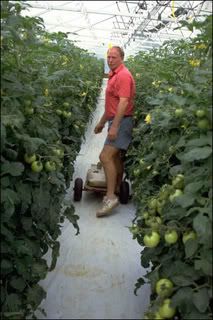You need to know some details if you are going to advance in this business. Here are the main ones to consider:
Nutrient problems:
a. What is the temperature of the solution - daytime and seasonal? Is there anything in your water which will restrict nutrient availability to the crops?
b. How's the pH? Does the range vary too much?
c. What is the electrical conductivity (EC) of the solution?
d. How's your water supplier? What is the dissolved solid content and does it vary to extremes? If you don't know, ask the supplier.
e. For each crop cycle, do you have different nutrient formulas for each plant growth stage?
f. Have you considered how plant growth effects your nutrient solution, especially a drop in nutrient levels in the supply tank, change of EC,and even pH?
g. Have you considered the reasons for changing the nutrient solution to avoid salt, plant waste buildup and loss of nutrient strength?
h. Do you have pathogens from sick plants or from contaminated water?
Most problems of poor plant growth can be traced to one or more of the above. Avoid extremes and remember in hydroponics you must be on the lookout for anything which can go wrong with the root system of your plants.
Let's look at your water supply:
If you live on a city water main, you can call the proper agency and get a copy of the most recent "readout" of what's in your water. Or you can have your water analyzed in a lab set up for such purposes. A smart thing to do is use a meter which measures dissolved solids (EQ, or PPM - this is a parts per million meter). You should have one at hand at all times.
One thing to watch out for: most city water supplies have carbonates of magnesium and calcium. Plants need these chemicals but not over 75 PPM for magnesium and 200 PPM for calcium.
Water temperature is also important. Root areas of most plants prefer 65 to 80 degrees Fahrenheit (18-27 Centigrade). Winter crops will want this to be a little cooler; tropical plants will want it to be a little warmer. Beware of abrupt temperature changes.
City water supplies are usually too high in pH, so you will have to correct for this. pH is all right for most plants if it fluctuates between 5.5 and 7.0. In fact the feeding of the plant roots will cause this fluctuation. The only time to do anything is when the pH goes below 5.5 or above 7.0.
But check your ph meter first - it could be out of adjustment. As always, when in doubt read the instructions which came with the instrument. Or re-check with another method.
What about your media?
Cheap stuff will give not only cheap but bad results. You can get plenty of high pH readings with some media, such as gravel. So take a sample and place it in a bowl of distilled water. Then check the water's pH daily for a week to ten days. Media problems have forced many growers to grow by using the various water methods and no media at all.
Want to know when to change your nutrient?
Here's a simple way which will do the trick without a lot of guessing and tortured detours. Each plant has its own appetite, so you need something simple to keep up with all crops. You just need to keep your eye on things and to keep records of what you see.
When you start out with a freshly filled tank of nutrient solution, read the pH and EC of the solution. Write it down and the date. Then, as the plants grow and the nutrient level in the tank falls, take a reading again of the pH and EC. Use fresh water to fill to the top. Check again for ph and EC. If the nutrient strength of the solution drops quite a bit, add some nutrient to the solution.
Each time you add water, write down the amount. When the total additions equal tank capacity, drain the tank and start all over with a completely new and fresh supply of nutrient solution.
Simple and effective. And no guessing required.
Pathogens in nutrient solutions can be a seasonal problem:
The best way to avoid them is to keep a clean house. Don't let any dirt get into the system, either by chance or intent. You can do what a lot of growers do: at the work area doorway put a mat which has disinfectant in it and make sure every one who enters the growing area to thoroughly scrape the soles of their shoes into the mat.
Be sure you always use completely healthy plants. One diseased plant can ruin an entire crop. Get rid of those plants which do look suspicious. Drain your entire nutrient solution, clean the tank and refill with fresh nutrient solution.
Also always run with just water between every four or five runs of nutrient. This will get rid of the salt buildup.
Does this all seem like a lot? Not really. If you keep careful records, use the best hydroponic fertilizer available and carefully measure it out, use a "chiller" for nutrient solutions in summers when the root zone becomes too warm, you will become a grower who knows how to deal with his plants and who wants to produce a quality product.Then you will become a true professional which is what hydroponics needs.







